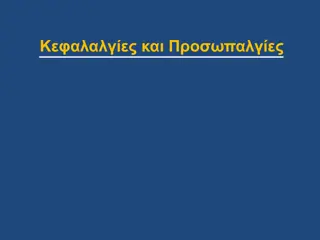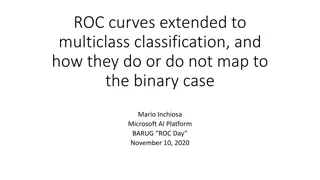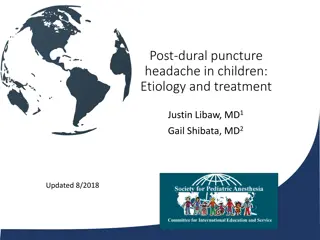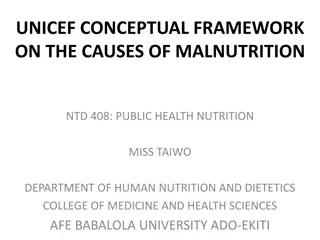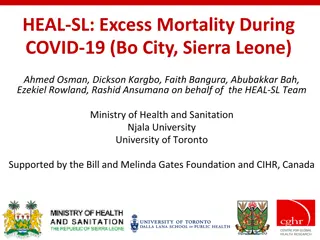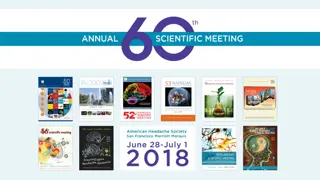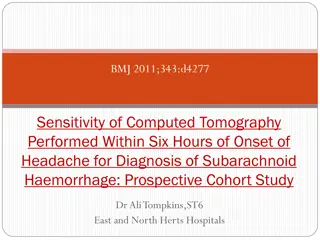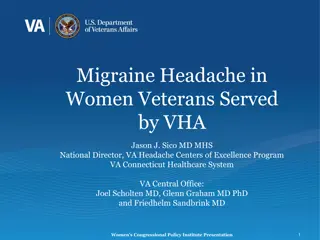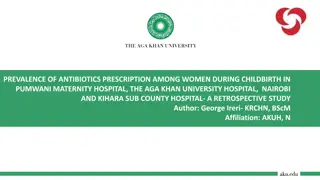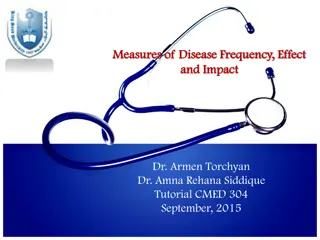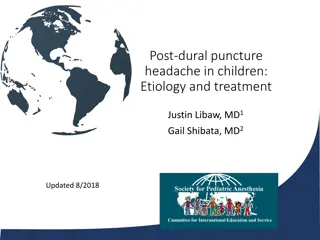Headache: Causes, Classification, and Prevalence
Headache is a prevalent symptom with various causes, including migraines, tension-type headaches, and cluster headaches. The International Headache Society's classification helps distinguish primary and secondary headache disorders, guiding necessary referrals. Headaches affect a significant portion of the population annually, with tension-type headaches and migraines being common. While the exact mechanisms are not fully understood, there are theories involving neurobiological and neurovascular factors. Genetic predisposition may also play a role in migraines.
Download Presentation

Please find below an Image/Link to download the presentation.
The content on the website is provided AS IS for your information and personal use only. It may not be sold, licensed, or shared on other websites without obtaining consent from the author.If you encounter any issues during the download, it is possible that the publisher has removed the file from their server.
You are allowed to download the files provided on this website for personal or commercial use, subject to the condition that they are used lawfully. All files are the property of their respective owners.
The content on the website is provided AS IS for your information and personal use only. It may not be sold, licensed, or shared on other websites without obtaining consent from the author.
E N D
Presentation Transcript
Lecturer: Ola Ali Nassr MSc Clinical Pharmacy Strathclyde University 12 Nov 2015 E-mail: ola.nassr@uomustansiriyah.edu.iq
Headache Headache is not a disease state or condition but rather a symptom, of which there are many causes. Headache can be the major presenting complaint; for example, in migraine, cluster, and tension-type headaches or one of many symptoms; for example, in an upper respiratory tract infection.
Headache classification The International Headache Society (IHS) classification is now almost universally accepted The system first distinguishes between primary and secondary headache disorders. This is useful to the community pharmacist because any secondary headache disorder is symptomatic of an underlying cause and would normally require referral.
Prevalence and epidemiology It has been estimated that up to 80% to 90% of the population will experience one or more headaches per year. Tension-type headache has been reported to affect between 30% and 80% of people, with age prevalence peaking between 20 to 40 years. Migraine affects 15% to 20% of women and is approximately two to three times more common than in men. The peak onset for a person to have their first attack is in adolescence or as a young adult (mean age of onset for men, 14 years; for women, 18 years). Conversely, cluster headache is more common in men; episodic cluster headache, which accounts for 90% of cases, is about four times more common and chronic cases 15 times more common in men than women. Age of onset is usually from 20 to 40 years
Considering headache affects almost everyone, the mechanisms that cause headache are still poorly understood. Pain control systems modulate headaches of all types, independent of the cause. Tension-type headache is commonly referred to as muscle contraction headache often exacerbated by stress. However, similar muscle contraction is noted in migraine sufferers, and this theory has now fallen out of favour. Consequently, no current theory for tension-type headache is endorsed, but recent studies suggest a neurobiological basis. Traditionally, migraine was thought to be a result of abnormal dilation of cerebral blood vessels, but this vascular theory cannot explain all migraine symptoms. The use of 5-HT1 agonists to reduce and stop migraine attacks suggests some neurochemical pathophysiology. Migraine is therefore probably a combination of vascular and neurochemical changes, the neurovascular hypothesis. Migraine also appears to have a genetic component, with about 70% of patients having a first-degree relative with a history of migraine.
pharmacist should also enquire about the persons social history because social factors mainly stress play a significant role in headache. Ask about the person s work and family status to determine whether the person is suffering from greater levels of stress than normal. Clinical features of headache In a community pharmacy, the overwhelming majority of patients (80% 90%) will present with a tension-type headache. A further 10% will have migraine. Very few will have other primary headache disorders, and fewer still will have a secondary headache disorder (see Tables 5.1 and 5.2).
Tension-type headache Tension-type headaches can be classed as either episodic or chronic. Episodic tension-type headache can be further subdivided into infrequent and frequent forms. Most patients will present to the pharmacist with the infrequent episodic form; that is, they occur less than once per month. Headaches last from 30 minutes to up to 7 days in duration. Pain is bifrontal or bioccipital, generalized and non throbbing (Fig. 5.1). The patient might describe the pain as a tightness or a weight pressing down on the head. The pain is gradual in onset and tends to worsen progressively throughout the day. Pain is normally mild to moderate and is not aggravated by movement, although it is often worse under pressure or stress. Nausea and vomiting are not associated with tension-type headache, and it rarely causes photophobia or phonophobia. Overall, the headache has a limited impact on the individual, although he or she might have tried OTC medication without complete symptom resolution or say that the headaches are becoming more frequent. Patients who have frequent episodic tension-type headaches suffer more frequent headaches (more than monthly episodes) and, over time, these can develop into chronic tension-type headache. Headaches occur on at least 10 episodes per month and might be daily, lasting for at least 3 months. These types of headaches can severely affect the patient s quality of life and should not be managed by the community pharmacist.
Migraine Migraines are rare over the age of 50 and anyone in this age group presenting for the first time with migraine-like symptoms should be referred to the doctor to eliminate secondary causes of headache. If this is not their first attack, they will normally have a history of recurrent and episodic attacks of headache. Attacks last anywhere from 4 to 72 hours. The average length of an attack is 24 hours. The IHS classification recognizes several subtypes of migraine, but the two major subtypes are migraine with aura (classic migraine) and migraine without aura (common migraine). A migraine attack can be divided into three phases: Phase one: Premonitory phase, which can occur hours or possibly a couple of days before the headache. The patient might complain of a change in mood or notice a change in behaviour. Feelings of well-being, yawning, poor concentration and food cravings have been reported. These prodromal features are highly individual but are relatively consistent to each patient. Identification of triggers is sometimes possible (Table 5.4). Phase two: Headache with or without aura. Phase three: Resolution phase, as the headache subsides; The patient can feel lethargic, tired and drained before recovery, which might take several hours.
Headache with aura (classic migraine) This accounts for less than 25% of migraine cases. The aura, which is fully reversible, develops over 5 to 20 minutes and can last for up to 1 hour. It can be visual (accounts for 90% of auras experienced) or neurological. Visual auras can take many forms, such as scotomas (blind spots), fortification spectra (zigzag lines) or flashing and flickering lights. Neurological auras (pins and needles) typically start in the hand, migrating up the arm before jumping to the face and lips. Within 60 minutes of the aura ending, the headache usually occurs. 1. Pain is unilateral, throbbing and moderate to severe. 2. Sometimes the pain becomes more generalised and diffuse. 3. Physical activity and movement tend to intensify the pain. 4. Nausea affects almost all patients but less than one-third will vomit. 5. Photophobia and phonophobia often mean that patients will seek out a dark quiet room to relieve their symptoms. 6. The patient might also suffer from fatigue, find concentrating difficult, and be irritable.
Headache without aura (common migraine) The remaining 75% of sufferers do not experience an aura but do suffer from all other symptoms, as described above. Other likely causes of headache Eye strain People who perform prolonged close work for example, visual display unit (VDU) operators can suffer from frontal-aching headache. In the first case, patients should be referred to an optician for a routine eye check. Sinusitis The pain tends to be relatively localised, usually orbital, unilateral, and dull. A course of decongestants could be tried, but if treatment failure occurs, referral to the doctor for possible antibiotic therapy would be appropriate.
Unlikely causes 1.Cluster headache Typically, the headache occurs at the same time each day with abrupt onset and lasts between 10 minutes and 3 hours, with 50% of patients experiencing nighttime symptoms. Patients are awoken 2 to 3 hours after falling asleep, with very intense, unilateral, orbital-boring pain. Additionally, conjunctival redness, lacrimation and nasal congestion (which laterally becomes watery) are observed on the pain side of the head. Facial flushing and sweating are common. Patients tend to be restless and irritable and often pace the floor. The condition is characterized by periods of acute attacks, typically lasting a number of weeks to a few months, with sufferers experiencing between one and three attacks per day. This is then followed by periods of remission, which can last months or years. During acute phases, alcohol can trigger an attack. Nausea is usually absent, and a family history is uncommon. Referral is required because subcutaneous sumatriptan is required.
2.Medication-overuse headache Patients with long-standing symptoms of headache who regularly use medicines to treat pain can develop medication overuse headache. Pain receptors (nociceptors) instead of being switched off when analgesics are taken, are in fact switched on. The consequence is a cycle where patients take more and more painkillers that are stronger and stronger to control the pain. Patients will experience daily or near-daily headaches described as dull and nagging. Obviously, in these cases, a medication history is essential and should prompt the pharmacist to refer the patient to the doctor. Treatment is to stop all analgesia for a number of weeks, which requires careful planning. Symptoms usually resolve within 2 months of withdrawing the medication.
3.Temporal arteritis (giant cell arteritis) The temporal arteries that run vertically up the sides of the head, just in front of the ears, can become inflamed. Unilateral pain is experienced, and the person generally feels unwell, with fever, myalgia and general malaise. Scalp tenderness is seen about 50% of patients. It is most commonly seen in older white populations and is three times more common in women. Prompt treatment with oral corticosteroids is required because the retinal artery can become compromised, leading to blindness. Urgent referral is needed.
4.Trigeminal neuralgia Pain follows the course of the second (maxillary; supplying the cheeks) or third (mandibular; supplying the chin, lower lip, and lower cheek) division of the nerve, leading to pain experienced in the cheek, jaws, lips or gums. Pain is short lived, usually lasting from a few seconds to a couple of minutes. Pain is severe and lancing (electric shock like) and is almost always unilateral. The person may experience many attacks a day, although the events are episodic and may remit for weeks or months before returning. It is more common in women than in men and rarely seen before the age of 40 years.
5.Depression A symptom of depression can be tension-type headaches. However, other more prominent symptoms should be present. The Diagnostic and Statistical Manual of Mental Disorders (DSM-5) criteria are often used to aid a diagnosis of depression. The pharmacist should check for a loss of interest or pleasure in activities, fatigue, inability to concentrate, loss of appetite, weight loss, sleep disturbances and constipation. If the patient exhibits some of these features (especially loss of interest in doing things and feeling down and hopeless), referral to the doctor is necessary. Recent changes to the patient s social circumstances might also support your differential diagnosis.
Very unlikely causes 1. Glaucoma (red, pain,cloudy) 2. Meningitis (fever) 3. Subarachnoid haemorrhage The patient will experience an incapacitating headache with very intense severe pain, located in the occipital region. Nausea and vomiting are often present, and a decreased lack of consciousness is prominent. Patients often describe the headache as the worst headache they have ever had. It is extremely unlikely that a patient would present in the pharmacy with such symptoms
1.Migraleve Migraleve is available as Migraleve Pink tablets, which contain a paracetamol-codeine combination (500/8 mg) plus buclizine, 6.25 mg, or Migraleve Yellow tablets, which contain only the analgesic combination. 2. Midrid Midrid capsules contain isometheptene mucate, 65 mg, and paracetamol, 325 mg. 3.Prochlorperazine (Buccastem M) Prochlorperazine has been found to be a potent antiemetic in a number of conditions, including migraine. It works by blocking dopamine receptors found in the chemoreceptor trigger zone. It is administered via the buccal mucosa, and therefore patients will need to be counselled on correct administration.
4. Sumatriptan Sumatriptan was the first triptan to be marketed in the UK and, subsequently, deregulated to OTC status. Triptans are 5-HT1 agonists and stimulate 5-HT1B and 5-HT1D receptors. Triptans cause constriction of the cranial blood vessels, stop the release of inflammatory neurotransmitters at the trigeminal nerve synapses, and reduce pain signal transmission.
Midrid Midrid is licensed for use only in adults. The dosage is two capsules at the start of an attack, followed by one capsule every hour until relief is obtained. A maximum of five capsules can be taken in a 12-hour period. It is a sympathomimetic agent and, like decongestants, it interacts with monoamine oxidase inhibitors (MAOIs), which might lead to fatal hypertensive crisis. It can also affect diabetes and hypertension control. Side effects reported with Midrid include transient rashes and other allergic reactions. Midrid is best avoided in pregnancy and breastfeeding due to lack of data.
Sumatriptan Patients over the age of 18, but younger than 65, should take a single tablet of sumatriptan (Migraitan; 50 mg) as soon as possible after the onset of the headache. If the headache clears and then recurs, a second tablet can be taken, provided there was a response to the first tablet and more than 2 hours have elapsed between the first and second tablets. No more than 100 mg can be taken during any 24-hour period. If there is no response to the first tablet, a second tablet should not be taken for the same attack. Sumatriptan is associated with a well-recognized side effect profile, with the most common adverse events being dizziness, drowsiness, tingling, feeling warm, flushed or weak, sensation of heaviness in any part of the body, shortness of breath, and pressure in the throat, neck, chest and arms or legs. Triptans are associated with rare cases of cardiac disorders and therefore, to allow wider availability via OTC sales, the warnings associated with prescription use have become contraindications. Those patients ineligible for OTC use are as follows: A previous myocardial infarction, ischaemic heart disease, peripheral vascular disease, cardiac arrhythmias, and history of transient ischaemic attack and stroke Known hypertension History of seizures Hepatic and renal impairment Atypical migraines used safely in the first trimester of pregnancy, and breastfeeding can be continued providing that 12 hours have elapsed since taking the dose. Given that triptans are not given continuously, and that the drug has poor bioavailability (14%), the amount of sumatriptan that reaches the infant s circulation is expected to be very low (<1%).








